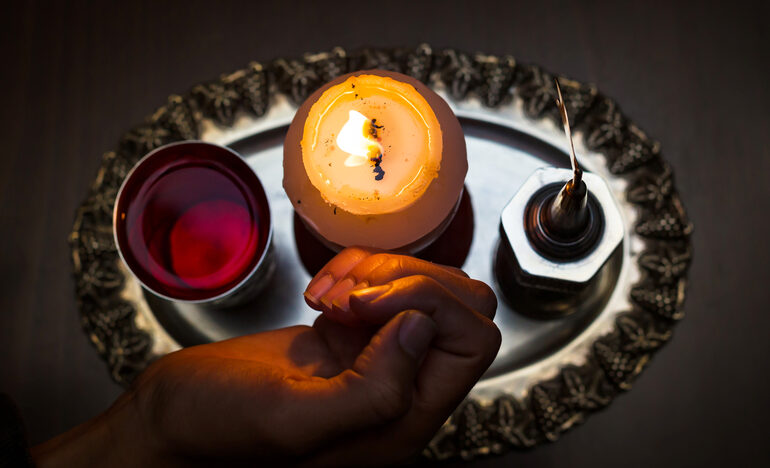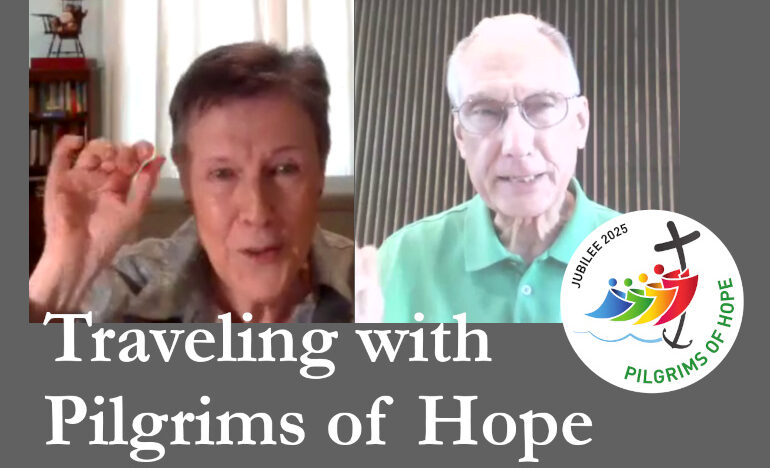The Jewish Holiday of Shabbat: A Time of Refreshment, Part 2 of 2

By Kathy Keary
Our full series on Contemplative Life is here.
Our new series on Judaism and Contemplation is here.
Our last article served as an introduction to Shabbat, a time of sacred rest, and delved into the Shabbat meal that takes place in Jewish homes on Friday evenings. We now turn our attention to the weekly Sabbath services that take place at the synagogue.
After the Shabbat meal, Jewish families travel to the synagogue for prayer. The format of the service is similar to what one would experience the other nights of the week except several prayers and blessings are added to welcome Shabbat. It is customary to sing L’kha Dodi (“Come my beloved”), a poem written in a sixteenth-century mystical community, followed by the reading of Psalm 92, a “Song for Shabbat.” Musical instruments are not allowed in Orthodox communities; however, in more liberal congregations, it is common to experience piano, guitar, or organ music accompanying singing.
Ong Shabbat (“Delight of the Sabbath”) follows the Friday night service in many congregations. This is typically a social hour or an opportunity for educational pursuits such as attending a lecture.
The Jewish people then gather once again at the synagogue on Saturday morning. The service begins with honoring the Torah with prayer and song as it is removed from the Ark. The Torah is then processed through the congregation as people reach out to touch it with a prayer book or tallit (prayer shawl). They then touch their lips with the prayer book or tallit symbolizing their love for the sacred text.
The service also includes multiple readings from the Torah. A blessing is required before and after each reading spoken from an elevated platform known as a bima representing the belief that reading from the Torah is comparable to ascending to a higher plane. The service includes prayers, singing, and a sermon. Sometimes a Bat Mitzvah or Bar Mizvah is celebrated. This marks the coming of age and a confirmation of faith of a 12-year-old girl or 13-year-old boy (Falcon, 252).
Shabbat concludes at nightfall on Saturday approximately 45 minutes after sundown when at least 3 stars can be seen in the sky. Many communities invite Shabbat to remain with them a little longer by taking part in a ceremony celebrated after nightfall either at the synagogue or in the home. This celebration is called Havdalah which means separation (Falcon, 252).
Havdalah begins with completely filling a small wine cup. Some even allow the wine to spill over symbolizing the overflowing blessings for the week. They then light the Havdalah candle, a special candle with two wicks. The leader raises the cup of wine as they recite a blessing: “Blessed are You, Eternal One our God, Universal Ruling Presence, Creator of fruit of the vine” (Falcon 252, 253).
Note: Never miss an article published on the Renewal Center website: Sign up to receive our newsletters.
It is also customary to place sweet spices in a spice box to add a pleasant fragrance to Havdalah. Rabbi Ted Falcon explains the rationale for this practice: “The spices are like ‘Jewish smelling salts’ – they bring people back to their ‘real world’ senses, compensate for the fact that Shabbat is leaving, and wake up the ‘ordinary’ soul.” The leader then raises the spice box as a blessing is recited. The spice box is passed around so that everyone can enjoy the aroma.
Attention is then drawn to the havdalah candle. While a blessing is said, everyone curls their fingers as depicted in the above picture and looks at the light of the candle reflected on their fingernails. Rabbi Falcon comments that both the light and the shadow are noted symbolizing that “both light and shadow result from the One Light” (Falcon, 253).
Havdalah concludes with one person raising the cup of wine and reciting this profound blessing:
Blessed are you, Eternal One our God, Universal Ruling Presence, Who makes a distinction between holy and ordinary, between light and darkness, between Israel and the other nations, between the seventh day and the six days of work. Blessed are You, Eternal One, Who makes a distinction between that which is holy and that which is not yet holy.
Everyone then takes a drink of the wine and then extinguishes the candle in the remaining wine. The people then greet one another with the words, “Shavuah tov” or “good week.” While this marks the end of Havdalah, some Jews continue the celebration with a party (Falcon, 254).
The 20th-century Jewish theologian, Rabbi Abraham Joshua Heschel, describes Shabbat as “a cathedral in time” noting that it is a place in time where the Jewish people can develop the practice of sacred rest as they focus on being in the world (My Jewish Learning).
Both the Christian and Islamic faiths adapted the Jewish Shabbat. The Islamic sabbath is celebrated on Friday, the Jewish sabbath takes place on Saturday and the Christian sabbath is recognized on Sunday. Rabbi Falcon beautifully points out: “Should there ever come a time when these three great Abrahamic traditions can honor each other as authentic paths to a shared Universal Truth, everyone would be enriched with the energies of a shabbat that spans three days” (Falcon, 255).
References
Falcon, Ted and Blatner, David. Judaism for Dummies. Hoboken, New Jersey: John Wiley and Sons, Inc, 2019.
“The Significance of Shabbat.” My Jewish Learning. https://myjewishlearning.com/article/shabbat-themes-and-theology
Photo 66634996 / Havdalah © Natushm | Dreamstime.com
Kathy Keary, spiritual director, holds a bachelor’s degree in Education, a master’s Degree in Theological Studies, and completed Sophia Center’s Souljourners Program, an intense study of spirituality and spiritual direction. Kathy believes that the Divine is present and active in all of life and encourages others to be awakened to the God in all including the divine within. She enjoys accompanying others on their journey to wholeness discovering the person they were created to be.
We’d Like to Hear from You!
We’d like to know what you think about this article. Send us a comment using the form below. Do you have a suggestion? Is there something you want to learn more about? Send us a note.
Related

Take Nothing for the Journey
An Assembling God’s Puzzle video
By Fr. Garry Richmeier, C.PP.S.
Jesus’ teaching about what to take on a journey — nothing — is actually good advice for building trusting relationships. Don’t bring your “stuff” into the relationship; listen deeply and respec their views and situation, understand their struggles.

Pilgrims of Hope, Episode 6: Walking with Cancer Survivors
Hosted by Fr. Ron Will, C.PP.S.
We are talking with people who find hope amid difficult circumstances or bring hope to others. In this episode, Kathy Keary talks about how centering prayer, journaling and other spiritual practices helped her cope with two life threatening health issues.
Categories
Assembling God's Puzzle Coffee with Padre Cooking & Spirituality Encounters of the 4th Kind Family Matters Reflections on the Eucharsitic Prayers Spiritual Resources Taize Prayers The Contemplative Life Traveling with Pilgrims of Hope Uncategorized Videos Week of Prayer for Uhristian Unity When you need a little help
